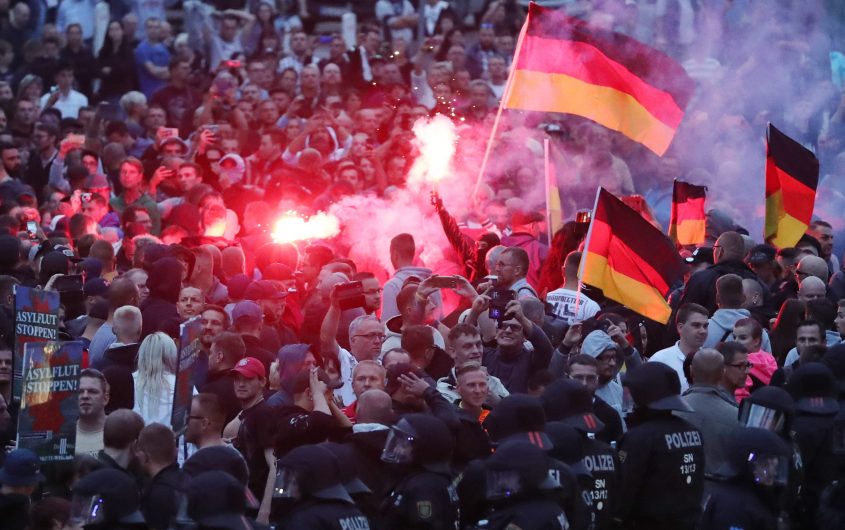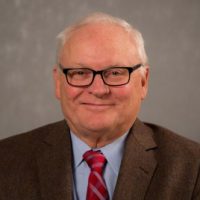
Jan Woitas/picture alliance via Getty Images
Germany’s Charlottesville Moment

Stephen F. Szabo
Senior Fellow
Dr. Stephen F. Szabo is a Senior Fellow at AICGS, where he focuses on German foreign and security policies and the new German role in Europe and beyond. Until 2017, he was the Executive Director of the Transatlantic Academy, a Washington, DC, based forum for research and dialogue between scholars, policy experts, and authors from both sides of the Atlantic. Prior to joining the German Marshall Fund in 2007, Dr. Szabo was Interim Dean and Associate Dean for Academic Affairs and taught European Studies at The Paul H. Nitze School of Advanced International Studies, Johns Hopkins University. He served as Professor of National Security Affairs at the National War College, National Defense University (1982-1990). He received his PhD in Political Science from Georgetown University and has been a fellow with the Alexander von Humboldt Stiftung, the Woodrow Wilson International Center for Scholars, and the American Academy in Berlin, as well as serving as Research Director at AICGS. In addition to SAIS, he has taught at the Hertie School of Governance, Georgetown University, George Washington University, and the University of Virginia. He has published widely on European and German politics and foreign policies, including. The Successor Generation: International Perspectives of Postwar Europeans, The Diplomacy of German Unification, Parting Ways: The Crisis in the German-American Relationship, and Germany, Russia and the Rise of Geo-Economics.
The protests and violence that took place last week in Chemnitz have brought home the depths of the western revolt against the liberal order which has been the norm in most of Europe and North America for almost three quarters of a century. That this type of protest and violence occurred in Germany is shocking given the Federal Republic’s ability to limit right-wing and neo-Nazi sentiments and expectations that Germany could serve as the center of a reconstituted liberal order. Given its history and its strong efforts to avoid a repetition, the assumption has been that Germany has been inoculated from the virus which has been growing in most of the West. While its neighbors have been getting the flu, it seemed that the vaccine in Germany would limit the impact of the disease. While neo-Nazi symbols and ideology were widely visible in Charlottesville last year, it is much more disturbing to see Hitler salutes in Germany. Do these assumptions have to be revised and has Germany become part of this new form of “normalization”?
Just as Charlottesville revealed the extensive networks of racist and neo-Nazi groups in the United States and shook Americans out of their complacency, so Chemnitz has forced Germans to confront the fact that they are not immune to this virus.
Just as Charlottesville revealed the extensive networks of racist and neo-Nazi groups in the United States and shook Americans out of their complacency, so Chemnitz has forced Germans to confront the fact that they are not immune to this virus. As in Virginia, the police in Chemnitz were overwhelmed and unprepared for the numbers of protesters both peaceful and violent. Social media was also an important element in mobilizing the right and spreading fake stories to inflame the public and play on its fears of crime and The Other. The rise of right-wing parties both in the U.S. and in Germany with their attacks on fake news and political correctness have legitimized far-right appeals and arguments.
Yet Germany is not the U.S., Italy, or Hungary. Even with the rise of the new-right Alternative for Germany (AfD), support for what can be considered far-right groups in Germany is certainly less that in most of its European neighbors, with less than 20 percent of the electorate supporting far-right parties. It is instructive that these events occurred in eastern Germany, the part of the country which was in the former Communist German Democratic Republic (GDR). Unlike their western compatriots, east Germans were not socialized in the history of the Holocaust until after unification in 1990. They did not have the confrontation with the past as their government held that they were part of the Communist resistance to Hitler and were liberated by the Soviet Army. Nazism was attributed to capitalism and to those Germans in West Germany who were the perpetrators of Hitler’s crimes. In addition, nationalist feelings were suppressed in both Germanies, but especially in the GDR. East Germany was also a foreigner-free zone with small numbers of non-Germans living there during the Cold War—and this continues to be the case. Chemnitz is an interesting exception as the foreign-born percentage of the population there is close to 8 percent due in part to the open-door policy for Syrian and other refugees started by Chancellor Merkel in 2015. While western Germans are also concerned about the impact of immigration and the Bavarian Christian Social Union (CSU) is facing a challenge from the AfD in the upcoming state election in Bavaria, the depth of radical racist resentment and attacks on foreigners is much higher in the east. The AfD polls much better in the east than in the west, receiving close to 30 percent of the vote in the 2017 federal election in Chemnitz.
While western Germans are also concerned about the impact of immigration and the Bavarian Christian Social Union (CSU) is facing a challenge from the AfD in the upcoming state election in Bavaria, the depth of radical racist resentment and attacks on foreigners is much higher in the east.
In short, Germany is like the United States in that disgruntled groups who feel left behind are supporting these extremist appeals. The fact that eastern Germans vote so disproportionately for both the far-right and the ex-Communist left and are the home to neo-Nazi parties and terror networks is a warning that national unification is still very incomplete. However, the German economy is strong and distributes benefits more equitably than is the case in the U.S. The number of those who feel left behind is much smaller and inequality is far less. Although inequality is growing in both countries, the U.S. ranked number one on the GINI index of the degree of inequality of wealth distribution, while Germany ranked seventh. German politics is facing a period of instability as its party system fragments, but it is not nearly as deeply polarized as the U.S. There is still a broad common front opposing extreme-right groups and to this point the efforts of Stephen Bannon to export Breitbart’s appeals to Germany have been limited. In sharp contrast to Charlottesville, no senior leader has anything good to say about neo-Nazis and other racist groups.
Germans expect the state to be well organized and its failings in dealing with the influx of refugees have been deeply unsettling to many, but this is not the same as racism. Counter demonstrators have been more present than neo-Nazis and most of those who have demonstrated in Chemnitz are not sympathetic to the most extreme elements. Chemnitz is not a city that represents the future of Germany and Germans, including younger generations, remain deeply aware of the lessons of their history. The work of Lily Gardner Feldman and the AGI program on German efforts toward reconciliation also offer substantial evidence of this transformation of German culture. It is not surprising that outsiders take right-wing extremism in Germany more seriously than in other countries and Germans have been awakened to the dangers that remain within, but the inoculation should remain effective to this most recent strain of the virus.
Further Resources on What’s Happening in Chemnitz
Interview with foreign minister Heiko Maas
Interview with interior minister Horst Seehofer
Statement 1 from Federal Special Representative for Migration, Refugees and Integration
Statement 2 from Federal Special Representative for Migration, Refugees and Integration








